There are several types of houseplant bugs, and they’re all equally irritating and frustrating.
But it’s important to know the signs to look out for, and quickly identify an infestation before it spreads to your other indoor plants.
Below I will show you exactly how to identify common houseplant pests, and give you tips for treating them.
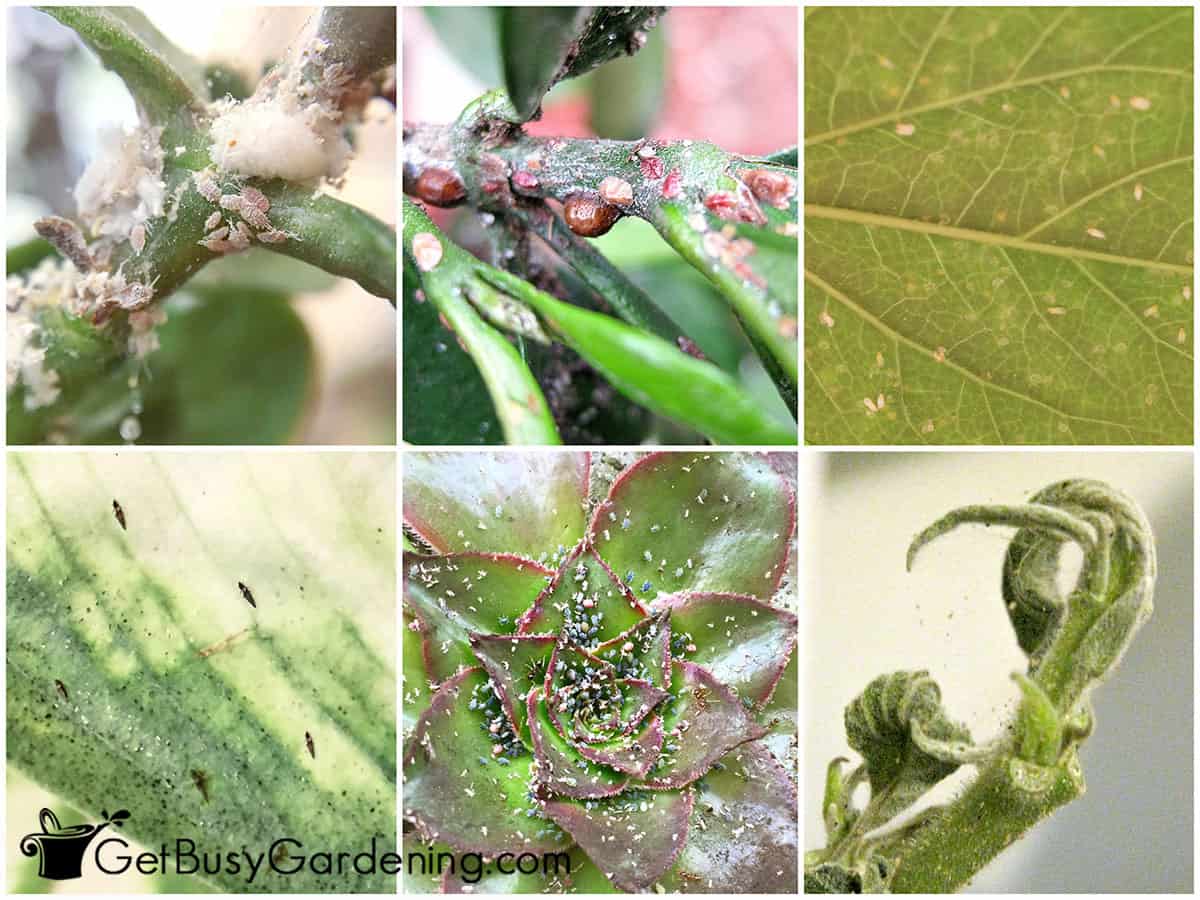
There are several types of houseplant bugs that can attack indoor plants. The good news is that each one has its own distinct characteristics, so they are easily identifiable.
Discovering that one of your beloved houseplants has an infestation is never fun. But, before you can effectively get rid of houseplant pests, you need to know which one you’re dealing with.
So in this guide, I’m going to talk about the most common bugs on houseplants, how to identify them, the symptoms and damage they cause, and also give you some quick tips for eliminating them.
What Are The Little Bugs In My Houseplants?
The first step to take as soon as you discover the infestation is to figure out what type of houseplant pest you’re dealing with.
First, I’m so sorry to hear that you found bugs on your houseplants, there is nothing more frustrating. I know the feeling, and I’ve been there many, many times.
Once you have a positive ID, it will make it much easier to eradicate them as quickly as possible. So let’s figure out what we’re dealing with here…
The Most Common Types Of Houseplant Bugs
Below I will go into details about how to identify common houseplant bugs, including what they look like, and the damage they do.
This will help you figure out what is eating your houseplants, so you can exterminate them quickly and efficiently.
For each kind of pest, I’ve also included a link to the page where you can learn even more, and find out exactly how to get rid of it for good.
Mealybugs
The funny thing about these soft-bodied scale insects is that they don’t even look like bugs at first glance.
Most people mistake them for fungus or mold on indoor plants. But, when you take a closer look, you can easily see that they are indeed bugs.
Identification: A mealybug infestation looks like cotton, small white fuzzy bugs, or white powder on houseplants.
They tend to cluster on the stems and leaf joints, or along the veins of the leaves. Most of the time they don’t appear to move, but they can sometimes be seen crawling around.
Symptoms/damage: The first sign of mealybugs is a white sticky substance, or white cotton-like bugs on houseplants. Damage includes stunted or deformed new growth, and leaf or bud drop.
Learn even more about mealybugs and how to get rid of them here.
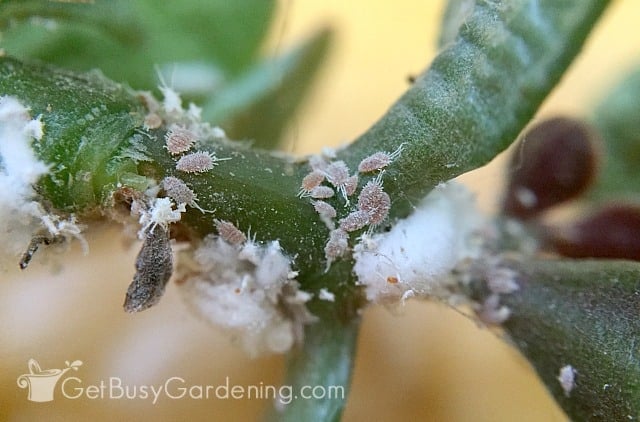
Spider Mites
The telltale sign of a spider mite infestation is fine webbing on houseplants. This webbing can be anywhere, but it usually starts on the undersides of the leaves, or at the tips of new growth.
Take a closer look, and you’ll see tiny mites crawling around on the webbing.
Identification: If you ever see spider webs on indoor plants, look closely. If there are little mites crawling around on the webbing, then you have just made a positive ID for spider mites.
Symptoms/damage: The first sign of spider mites is fine webbing on the leaves, between branches, or on fresh growth and flower buds.
Damage includes deformed, dead and dried out leaves, or the leaves and flower buds start dropping.
Learn even more about spider mites and how to get rid of them here.
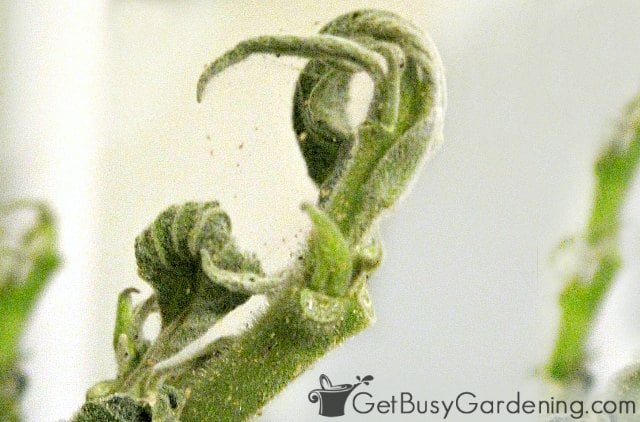
Whiteflies
Just as the name suggests, whiteflies look like tiny white flies or moths in houseplants.
They lay their eggs on the undersides of leaves, so the population can grow very large without being detected.
When you disturb an infested plant, the adults will flutter around, making them easy to identify.
Identification: If you see small white flying bugs fluttering around houseplants, then check under the leaves. You can easily see little white dots (eggs) and bugs (nymphs/adults) on the undersides of leaves.
Symptoms/damage: The first thing that most people notice is the damage that whiteflies cause.
Damaged leaves will turn yellow and drop from the plant. Other symptoms include white spots on the undersides of the leaves, and tiny white bugs flying around when you disturb the plant.
Learn even more about whiteflies and how to get rid of them here.
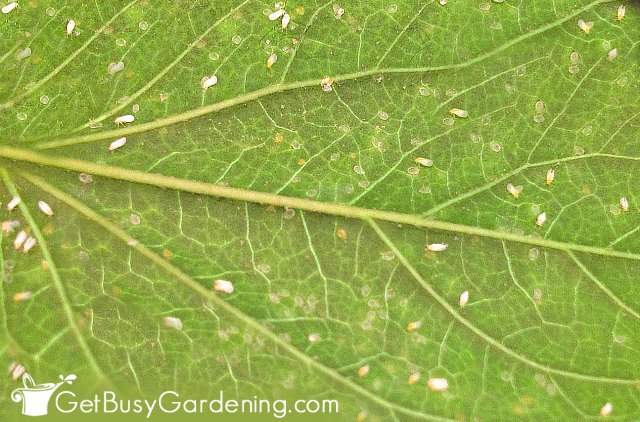
Fungus Gnats
By far the most common types of houseplant bugs are fungus gnats (also known as soil gnats).
They are those annoying little black gnats that you’ll see flying around houseplants, and crawling in the soil.
Since they live and breed in potting soil, they can be very difficult to control.
Identification: Small gnats flying around houseplants, tiny white worms in the soil, and/or black bugs crawling on top of the dirt.
Symptoms/damage: Thankfully fungus gnats are just annoying, and don’t cause much harm to healthy indoor plants.
However, they do feed on roots. So very large populations could damage weak or young houseplants.
Learn all about fungus gnats and how to get rid of them here.
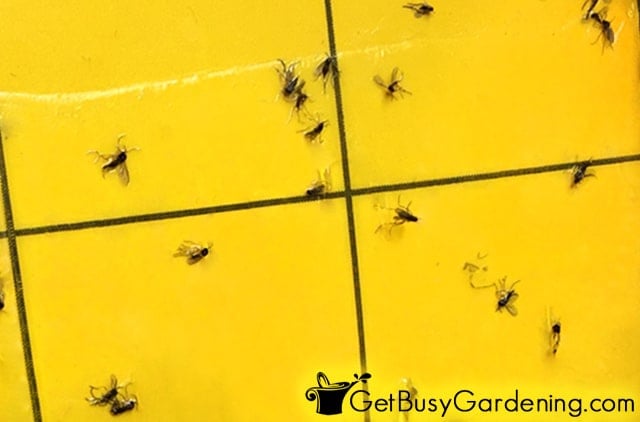
Aphids
Commonly found outside in the garden, aphids can get into the house and wreak havoc on your indoor plants. They multiply very quickly, and can spread like wildfire.
They usually cluster on new growth buds, making them more obvious. But many times they will blend in with the foliage, and can easily go unnoticed until the houseplant is completely infested.
Identification: Small, fat, juicy bugs clustering on new growth and flower buds. They can be a wide range of colors, from green, orange, red, brown, blue, or black.
There are usually lots of little white specks (the nymphs) around the clusters of adult aphids as well.
Symptoms/damage: Usually the first sign of that you’ll see is either tiny white flecks, or large clusters of insects.
You may also notice a sticky residue around the base of infested houseplants. Damage includes stunted and deformed growth, as well as leaf and bud drop.
Learn more about aphids and how to get rid of them here.
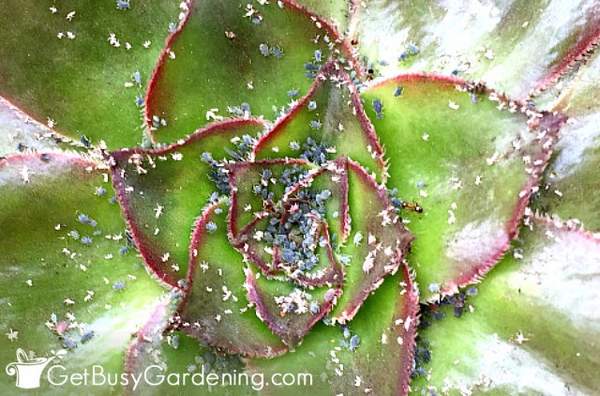
Scale
It can be very difficult to notice scale on a houseplant because they don’t look like bugs at all. They look like harmless bumps or scabs.
For that reason, they usually go unnoticed until the infestation grows very large – which is part of what makes them so hard to control.
Identification: Various sized brown, tan, grayish, or white colored bumps or spots on the leaves and stems.
Scale is often found clustering around the stem and leaf joints, and along the veins of the leaves.
Symptoms/damage: The first thing you’ll probably notice are the bumps or spots, and there may also be a sticky residue on or around the houseplant.
Scale insects don’t appear to move at all. But they come off easily when you scrape them with a fingernail. They usually leave behind small pock marks when removed.
Learn even more about scale and how to get rid of it here.
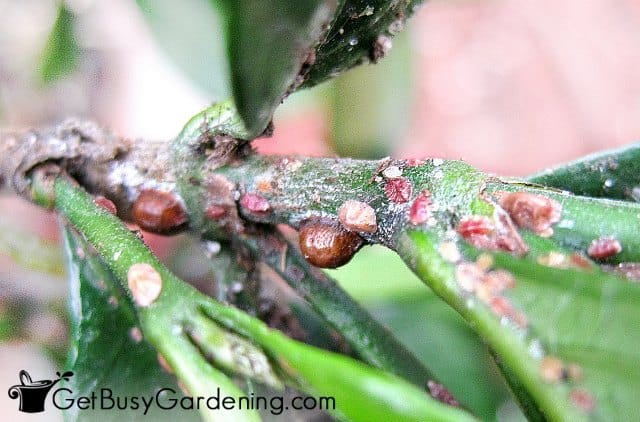
Thrips
This is another garden pest that can get inside and infest your houseplants. Since thrips are so small, they are difficult to see.
So an infestation can often go unnoticed until the population becomes very large.
The good news is that thrips are the least common of all of the types of bugs on houseplants we’ve discussed so far. So, hopefully you’ll never have to deal with them.
Identification: Small black bugs (they could also be brown, yellowish-green, or white in color) with skinny bodies and pointy tails.
The adults have wings, but they aren’t great flyers. So you will probably never see them flying around.
Symptoms/damage: Dull, white, or grayish looking houseplants, or the leaves look like they’re dirty.
Eventually the damaged parts will turn brown, and leaves and flower buds could begin dropping. New growth is often deformed.
Learn all about thrips and how to get rid of them here.
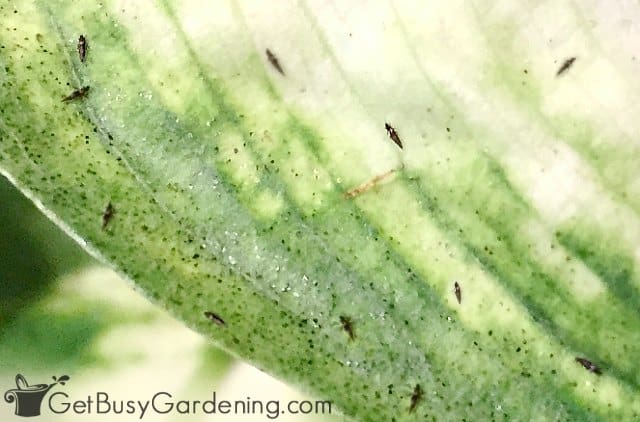
Tips For Treating All Types Of Houseplant Bugs
There is no one magical way to exterminate all of the different kinds of bugs on houseplants.
Many will require specific treatment methods based on their lifecycle, and behavior.
Also, it’s very important to keep in mind that all types of indoor plant bugs can quickly build up a resistance to chemical pesticides.
So, whatever you do, make sure you only use natural products on them.
To give you a quick head start, below I’ve listed some of the best organic treatment methods to try.
But you can learn all about using natural houseplant pest control remedies here.
- Hand picking – Dip a cotton swab in rubbing alcohol, then use it to kill and remove as many of the bugs as you can find.
- Insecticidal soap – Spraying the leaves with insecticidal soap will kill most of them on contact, giving you the upper hand.
- Strong stream of water – Simply rinsing the leaves with a strong stream of water from the hose, sink, or shower will quickly knock down the population.
- Neem oil – A naturally occurring pesticide, neem oil kills bugs when they feed on a houseplant. It also has a residual effect that helps deter them.
- Wash the leaves – Use a mild liquid soap to wash the leaves on the infested houseplant. Soap kills all houseplant bugs on contact.
- Soil covers – Covering the top inch of potting soil with a natural soil barrier can kill larvae, and help to prevent adults from laying eggs and reproducing.
- Sticky traps – Yellow and/or blue sticky traps work great to attract and capture flying bugs, like whiteflies, aphids, thrips and fungus gnats.
Now that you know exactly which types of houseplant bugs you’re dealing with, eradicating them is so much easier. Plus, you’ll be able to keep them from ever coming back.
If you struggle with constant bug infestations on your indoor plants, and want them gone for good, then my Houseplant Pest Control eBook is for you. It will show you exactly how to maintain bug-free indoor plants. Download your copy today!
More About Houseplant Pests
- How To Debug Plants Before Bringing Them Indoors
- How To Use Neem Oil On Indoor Plants
- Where Do Houseplant Pests Come From?
- How To Keep Cats Out Of Houseplants
Share your tips for identifying the various types of houseplant bugs in the comments section below.
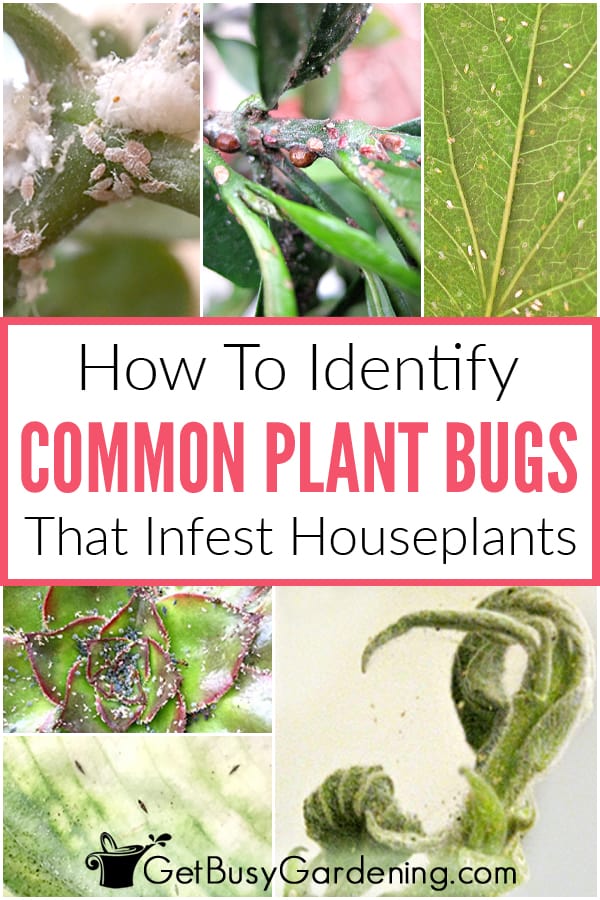
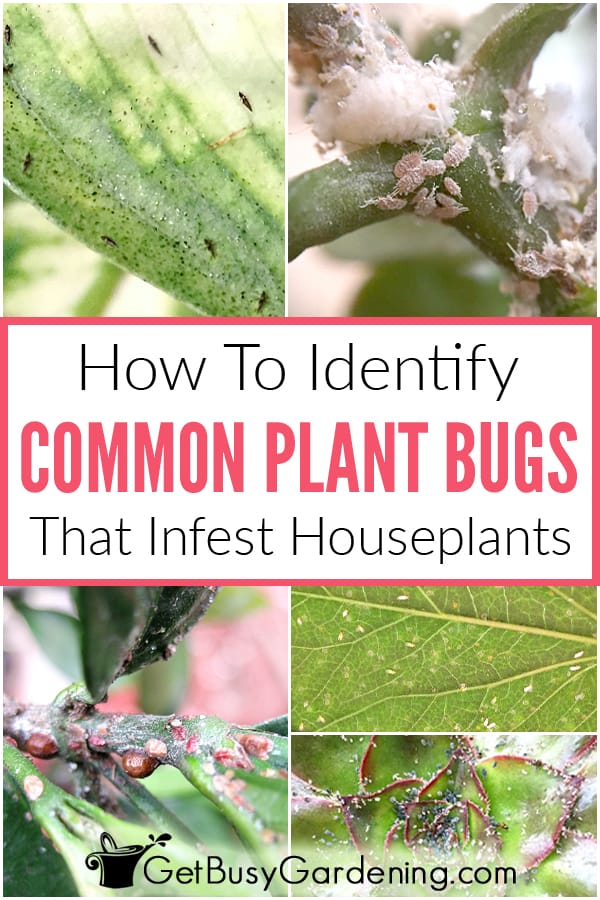
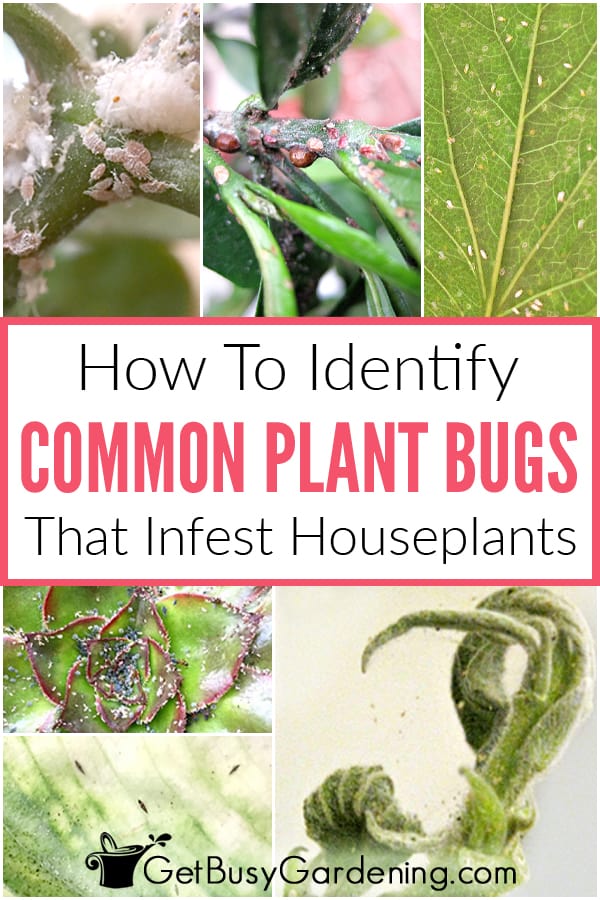

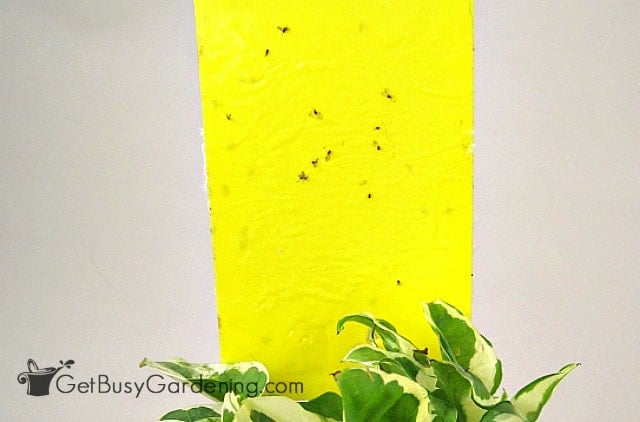


Fazeela Yoosuf says
Thank you so much for the useful info you have shared. Leaves of my mango seedlings were getting deformed and I found tiny black insects on the underside of them. They had me so worried because the infestation had spread to all the mango seedlings and a few others too..
Amy Andrychowicz says
You’re welcome, hope you get rid of those tiny black bugs soon!
Kathy says
I have what I think is a snake plant. On the underside of the saucer under the pot I found teeny tiny black bugs. I cleaned them all up, and saw none for a few months, but just now I turned the saucer over and there they were again. There’s none on the plant or in the soil that I can see. Any idea what they could be?
Amy Andrychowicz says
Those are most likely juvenile fungus gnats, they can’t fly yet but the can crawl around. Here’s how to get rid of them.
Miranda says
I just purchased a plant and found it infested with a long white worm like bug, the bug is very small about 1/4 of in in length maybe less and has tiny legs.
Many of the ends of my leaves have started to rot
Amy Andrychowicz says
That is most likely fungus gnat larvae. They lay their eggs in the soil, and their larvae are tiny white worms. Here’s how to get rid of them. The fact that they are present, and that the leaves are starting to rot tells me the plant is being overwatered.
Diane R. says
Your column is wonderful! I’m bookmarking it. My 6th floor glassed in balcony potted garden has never had bugs until this year. But 2 caladium’s’ stalks developed a thick coat of black stuff that looks like coffee grounds. Doesn’t seem to match your photos. They have kept their leaves fine, Now it’s October and I’m putting my pots away. Are the tubers and soil best just tossed? I was going to try for the first time to dig and overwinter them in peat moss in a cold dark basement storage area. I do try to reuse potting soil to save money. Bad idea?
Amy Andrychowicz says
Thank you, so glad you like it! Sorry to hear you plant is infested, that’s no fun! If you’re sure those are bugs on the stem (rather than mildew or disease), then my guess would either be aphids or scale. Both of those start are very small, can be almost any color, and tend to cluster. Take a closer look to see if they look more like a bug with visible legs (aphids), or if they look like small round bumps that don’t move (scale). I would treat the plant to try to get rid of as many as I could before overwintering them. If you want to try keeping them, then remove all of the soil and wash the tuber in soapy water, then spray it with neem oil first. However, you might just want to cut your losses and toss them out, soil and all, as the bugs can be difficult to get rid of. And definitely never reuse any of your potting soil. I know it seems like a good way to save money, but it’s a sure way to harbor pests and disease, which can quickly spread to all of your plants and become a huge headache (and costly to get rid of on a large collection). So, it’s always best to invest in fresh, sterile potting soil rather than risk a major outbreak.
ximena martinez says
hey so,i have checked up on this mango seed that i was trying to grow so today i decided to check on i saw a bunch of white stuff on it and i thought,maybe they were roots?so i put it in water only for them to come wiggling down to the bottom of the cup,only to realize they were worms,they were skinny not long and they clear,none of the ones on here look like them so that why i’m commenting this.
Amy Andrychowicz says
Those could be fungus gnat larvae, which look like tiny white worms.
Raquel Garcia says
I just found small clear bugs(?) on the new growth of my houseplant. They look like coarse salt but are extremely sticky. I haven’t seem any list of this type of insect and would like to know what it might be and how to treat it.
Amy Andrychowicz says
My guess is that those are either aphid nymphs, or whitefly eggs. Here’s how to control any type of houseplant bug, how to get rid of aphids (with photos), and how to get rid of whiteflies (with photos). Good luck!
Sharon says
Hello,
So I’ve read the previous messages and responses. I have been using neem , diatomaceous earth and several homemade remedies including veg oil, garlic, vinegar, soap, alcohol swabs, sticky traps, etc, etc… But my bug problems are still persisting.
Nothing new has entered for several months because of the issues. I have definitely seen a few mites, but the biggest problem is a bug that I see in the plant saucer and it is also reaking havoc on the underside of my plants, I sometimes see crawling on top layer of dirt and stems and causes browning on leaf tips. What do I have and how do I rid the problems?
I also just got some Bonide systemic insect control.
Please help I’m beyond desperate! Should also mention when I first noticed months ago I was watering a plant and the bugs came “pouring/running “ out of the plant like a scene out of a horror movie. Again, even that plant had been here almost two years.
Amy Andrychowicz says
The best way to get rid of bugs in the soil is to keep the top inch or so dry, because they thrive in damp soil. Also, neem oil is a long-term remedy, and it takes a bit of time to work. So you have to continue treat the plant regularly until all signs of the bugs are gone. Here are a few posts that will help you get rid of them. But in short, no matter what type of remedy you use, persistence is key!
How To Get Rid Of Bugs On Houseplants
How To Get Rid Of Fungus Gnats In Houseplants Soil
Petrina Mascarenhas says
Hi,
I picked an anthurium earlier this week from a grocery store. Today I noticed very tiny insects crawling on the soil. I’m not sure what to do and which of these that you listed above it is. This is my second plant ever. So I’m a novice and have no idea what to do next.
Regards!
Amy Andrychowicz says
Sounds like your new plant has fungus gnats, those are the ones that live and breed in the soil. A very, very common type of houseplant pests. Here’s how to get rid of them.
Candice says
I noticed yesterday 1 plant I have has tiny, and I mean tiny, almost not noticeable, little bugs crawling around on the soil. Leaves are fine. What could it be? And any recommendations for getting tid of them? Thanks!
Amy Andrychowicz says
Those tiny bugs in the soil are likely fungus gnats. Here’s the details about how to get rid of them.
Penny says
Hi Amy I really hope you can help me. I am plant sitting for friends while they get moved and now all of my plants have bugs all over them. I have mealy bugs spider mites and thrips for sure. And some others that look like specks of dirt or black pepper. I am using dr bronners baby and alcohol and neem oils and the first thing I did was was them all and repot them in new soil after washing sterilizing all the pots
they were in. It has taken a week just to do that and I’m checking them constantly. It’s just awful so any advice you can give me I would really appreciate. Now here’s the real question I have. Can mealy bugs infest the rest of my home? Because I’m seeing these little white fluffy things everywhere on windows and on my fabric shower curtain and my regular curtains and my shower curtain is grey and white and I noticed it looked like strings were raveling on it in the tops of the folds but with a magnifying glass they’re not really strings from the curtain and I’m just wondering if those are mealy bugs and if so can they live on things other than plants? I know this is a lot but I really need some help. So thank you in advance for anything you can offer.
Amy Andrychowicz says
Oh my, sorry to hear that all of your plants have become infested with several different type of bugs. In the future, I recommend keeping all new plants you bring into your home isolated from your others for at least a month. This will help to keep future infestations from spreading to your entire collection.
The good news is that the treatments you’re using will work to get rid of all of them. Unfortunately, repotting all of the plants won’t do anything to rid them of bugs, and it only puts even more stress on the plants. So, leave them in the pots you have them in, and don’t repot them again until all the bugs are gone, and the plants have recovered. Here’s a post about how to eliminate infestations that will give you tons of information to help you… How To Get Rid Of Bugs On Houseplants
While mealybugs can survive a long time without a host plant, they won’t infest your whole house. It’s not uncommon to find them on nearby surfaces, but not in random places throughout your house where there aren’t any plants. Read more about mealybugs here.
Sanda says
Hello
The leaves on yucca plant indoors has been curling. No one could figure out what the issue was.
Today I saw some very small thin long black bugs on the edges of the leaves. Think it’s thrips??
What do I do please? Shall I try the insecticidal soap and then neem oil?
Please let me know what is best
Thank you
Amy Andrychowicz says
Oh no, so sorry to hear that your yucca plant is not doing well. The bugs you describe sound like thrips to me too. Here’s an article that will help you with identification, and also show you the steps to take to get rid of them… How To Get Rid Of Thrips On Houseplants. Good luck!
Ann Parsons says
I have a persistent recurring bug that attacks my anthurium and Orchids. I cure it with houseplant insecticide spray but in no time at all the leaves develop little jelly like mounds between 2-3 mm in size . This leaves a sticky film on the leaves & the surrounding surface area.
How do I cure it permanently.
Amy Andrychowicz says
I recommend using the neem oil spray that I mentioned in the article above. Neem oil has a residual effect that will help to get rid of houseplant bugs for good. Here’s more info about it… How To Use Neem Oil Insecticide On Houseplants.